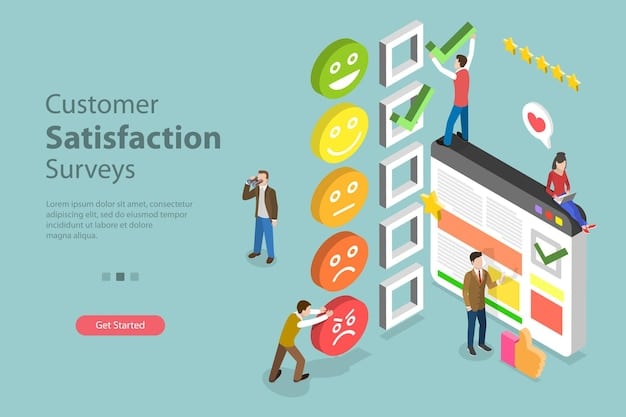Measure Customer Satisfaction Effectively: Key Metrics & Tools for 2025

Measuring customer satisfaction effectively in 2025 requires a multi-faceted approach, utilizing key metrics like Net Promoter Score (NPS), Customer Satisfaction Score (CSAT), and Customer Effort Score (CES), alongside advanced analytical tools to gain actionable insights and improve overall customer experience.
Are you ready to elevate your customer experience strategy? Understanding how to measure customer satisfaction effectively: key metrics and tools for 2025 is crucial for business success. Let’s dive into the strategies that will keep you ahead.
Understanding the Importance of Customer Satisfaction in 2025
In 2025, customer satisfaction isn’t just a buzzword; it’s a critical component of sustainable business growth. Satisfied customers are more likely to become loyal advocates, driving revenue and enhancing brand reputation. To truly measure and improve satisfaction, it’s vital to understand its underlying impact.
By prioritizing customer satisfaction, businesses can not only retain existing customers but also attract new ones through positive word-of-mouth and referrals. This creates a virtuous cycle that boosts overall business performance. The digital landscape of 2025 makes these effects even more pronounced.
The Impact of Customer Loyalty
Customer loyalty is a direct result of high satisfaction levels. Loyal customers are more likely to make repeat purchases, spend more, and recommend your brand to others. Understanding the value of customer loyalty allows businesses to make informed decisions about resource allocation.
- Increased Revenue: Loyal customers contribute a significant portion of a company’s revenue.
- Reduced Marketing Costs: Retaining customers is more cost-effective than acquiring new ones.
- Brand Advocacy: Loyal customers act as brand ambassadors, spreading positive messages.
Competitive Advantage Through Satisfaction
In a highly competitive market, customer satisfaction can be a key differentiator. Businesses that consistently deliver exceptional experiences are more likely to stand out from the crowd. This competitive edge can translate into increased market share and profitability.

Investing in customer satisfaction is an investment in long-term success. By prioritizing the customer experience, businesses can build a sustainable competitive advantage that drives growth and profitability.
Ultimately, understanding the importance of customer satisfaction in 2025 means recognizing its direct impact on customer loyalty, competitive advantage, and overall business success. By focusing on delivering exceptional experiences, businesses can thrive in an increasingly customer-centric world.
Key Metrics for Measuring Customer Satisfaction
To effectively measure customer satisfaction, businesses need to utilize a range of key metrics. These metrics provide valuable insights into different aspects of the customer experience, allowing businesses to identify areas for improvement and track progress over time. Three of the most important metrics are Net Promoter Score (NPS), Customer Satisfaction Score (CSAT), and Customer Effort Score (CES).
By understanding and implementing these metrics, companies can gain a comprehensive view of customer sentiment and make data-driven decisions to enhance satisfaction. Let’s explore each of these metrics in detail.
Net Promoter Score (NPS)
NPS measures customer loyalty and the likelihood of customers recommending your company to others. It’s based on a single question: “On a scale of 0 to 10, how likely are you to recommend our company/product/service to a friend or colleague?”
Customers are then categorized into three groups:
- Promoters (9-10): Loyal enthusiasts who will keep buying and refer others.
- Passives (7-8): Satisfied but unenthusiastic customers who are vulnerable to competitive offerings.
- Detractors (0-6): Unhappy customers who can damage your brand through negative word-of-mouth.
NPS is calculated by subtracting the percentage of Detractors from the percentage of Promoters. A high NPS indicates strong customer loyalty and satisfaction. Regularly tracking NPS can reveal trends and areas where improvements are needed.
Customer Satisfaction Score (CSAT)
CSAT measures how satisfied customers are with a specific interaction or experience. It typically uses a rating scale, such as “How satisfied were you with your recent purchase?” with options ranging from “Very Dissatisfied” to “Very Satisfied.”
CSAT surveys are often triggered after specific customer interactions, such as a purchase, customer service interaction, or product delivery. This provides immediate feedback on the customer experience and allows businesses to address any issues promptly.
CSAT scores are calculated by taking the percentage of customers who respond with “Satisfied” or “Very Satisfied.” Monitoring CSAT scores can help businesses identify touchpoints where customers are consistently dissatisfied and make targeted improvements.
Customer Effort Score (CES)
CES measures the effort customers expend when interacting with your company, such as resolving an issue or making a purchase. It’s based on the question: “How much effort did you personally have to put forth to handle your request?” with options ranging from “Very Low Effort” to “Very High Effort.”

CES is based on the principle that customers prefer experiences that are easy and frictionless. A low CES indicates that customers are able to achieve their goals with minimal effort, leading to higher satisfaction and loyalty.
CES scores are calculated by averaging the responses to the effort question. Tracking CES can help businesses identify processes or interactions that are causing unnecessary friction for customers and make improvements to streamline the customer journey.
In summary, effectively measuring customer satisfaction requires the use of key metrics like NPS, CSAT, and CES. By understanding and implementing these metrics, businesses can gain valuable insights into the customer experience and make data-driven decisions to enhance satisfaction and loyalty.
Tools for Effective Customer Satisfaction Measurement in 2025
In 2025, a variety of sophisticated tools are available to help businesses measure customer satisfaction effectively. These tools range from survey platforms and analytics dashboards to AI-powered sentiment analysis and social media monitoring. By leveraging these technologies, companies can gather comprehensive feedback, analyze trends, and make informed decisions to improve customer experiences.
Let’s explore some of the most effective tools for measuring customer satisfaction in the modern business landscape.
Survey Platforms
Survey platforms like SurveyMonkey, Qualtrics, and Google Forms are essential tools for collecting customer feedback. These platforms allow businesses to create and distribute surveys easily, gather responses, and analyze the data in real-time. They offer features such as customizable templates, branching logic, and integration with other business systems.
Survey platforms can be used to administer CSAT, NPS, and CES surveys, as well as gather qualitative feedback through open-ended questions. The data collected through these platforms can provide valuable insights into customer perceptions and preferences.
Analytics Dashboards
Analytics dashboards such as Tableau, Power BI, and Google Analytics provide a centralized view of customer satisfaction metrics and trends. These dashboards allow businesses to track NPS, CSAT, CES, and other relevant metrics over time, identify patterns and anomalies, and drill down into the data to understand the underlying causes of customer satisfaction or dissatisfaction.
Analytics dashboards can also integrate data from multiple sources, such as CRM systems, social media platforms, and customer service logs, to provide a holistic view of the customer experience.
AI-Powered Sentiment Analysis
AI-powered sentiment analysis tools like MonkeyLearn and Brandwatch use natural language processing (NLP) to analyze customer feedback from various sources, such as surveys, reviews, and social media posts. These tools can automatically detect the sentiment expressed in the feedback, whether it’s positive, negative, or neutral, and categorize it by topic or theme.
Sentiment analysis can help businesses identify emerging trends, uncover hidden insights, and prioritize areas for improvement. By analyzing large volumes of unstructured data, these tools can provide a deeper understanding of customer perceptions and preferences.
Social Media Monitoring
Social media monitoring tools like Hootsuite and Sprout Social allow businesses to track mentions of their brand, products, and services on social media platforms. These tools can help companies identify and respond to customer feedback, address complaints, and engage with customers in real-time.
Social media monitoring can also provide valuable insights into customer sentiment and brand perception. By tracking the volume and tone of social media conversations, businesses can gauge how customers feel about their brand and identify potential areas for improvement.
Ultimately, the right tools can significantly enhance a company’s ability to measure and improve customer satisfaction. By combining survey platforms, analytics dashboards, AI-powered sentiment analysis, and social media monitoring, businesses can gain a comprehensive understanding of the customer experience and make data-driven decisions to drive satisfaction and loyalty.
Best Practices for Implementing Customer Satisfaction Programs
Implementing effective customer satisfaction programs requires a strategic approach that aligns with business goals and customer needs. It’s not enough to simply measure metrics; businesses must also act on the insights they gain to drive meaningful improvements in the customer experience. Several best practices can help companies implement successful customer satisfaction programs and achieve tangible results.
Let’s explore some of the key strategies for implementing customer satisfaction programs that deliver real value.
Set Clear Goals and Objectives
Before launching a customer satisfaction program, it’s essential to define clear goals and objectives. What specific outcomes do you want to achieve? Do you want to increase NPS, improve CSAT scores, or reduce customer churn? By setting measurable goals, you can track progress and evaluate the effectiveness of your program.
Your goals should be aligned with your overall business strategy and reflect your commitment to delivering exceptional customer experiences. Clearly defined objectives will also help you prioritize your efforts and allocate resources effectively.
Gather Feedback Regularly
Customer satisfaction is a moving target, so it’s important to gather feedback regularly and consistently. Don’t wait until you start seeing problems; proactively solicit feedback at various touchpoints throughout the customer journey. Use a variety of methods, such as surveys, interviews, and social media monitoring, to capture a diverse range of perspectives.
Regular feedback will help you identify trends, detect emerging issues, and track the impact of your improvement efforts. The longer the insights gathering and analysis process, the less effective your initiatives will be.
Act on Feedback Promptly
Gathering feedback is only half the battle; the real value comes from acting on it promptly. When customers provide feedback, whether positive or negative, acknowledge their input and take appropriate action. Respond to complaints quickly, address concerns, and implement changes based on customer suggestions.
Demonstrating that you value customer feedback and are committed to making improvements will build trust and loyalty. Customers are more likely to continue doing business with a company that listens to their concerns and takes action to resolve them.
Personalize the Customer Experience
Customers appreciate personalized experiences that cater to their individual needs and preferences. Use the data you collect through your customer satisfaction program to personalize interactions, tailor offers, and provide relevant recommendations. Personalization can significantly enhance customer satisfaction and loyalty.
For example, you can use customer data to personalize email campaigns, recommend products based on past purchases, or provide customized support based on customer history.
By following these best practices, businesses can implement customer satisfaction programs that deliver measurable results. Setting clear goals, gathering feedback regularly, acting on feedback promptly, and personalizing the customer experience can all contribute to increased customer satisfaction and loyalty.
Future Trends in Customer Satisfaction Measurement
As technology advances and customer expectations evolve, the landscape of customer satisfaction measurement is constantly changing. In 2025 and beyond, several key trends are poised to reshape how businesses understand and respond to customer needs. Staying ahead of these trends will be crucial for companies that want to maintain a competitive edge and deliver exceptional experiences.
Let’s explore some of the future trends in customer satisfaction measurement that are expected to have a significant impact.
Increased Use of Artificial Intelligence (AI)
AI will play an increasingly important role in customer satisfaction measurement, particularly in areas such as sentiment analysis, predictive analytics, and personalized feedback. AI-powered tools will be able to analyze vast amounts of data from various sources to identify patterns, predict customer behavior, and provide personalized recommendations.
For example, AI can be used to analyze customer feedback from surveys, reviews, and social media posts to identify the underlying emotions and attitudes. This can help businesses understand what customers are feeling and why, and take appropriate action to address their concerns.
The Rise of Real-Time Feedback
Traditional methods of customer satisfaction measurement, such as surveys and interviews, often provide feedback that is delayed and retrospective. In the future, there will be a greater emphasis on real-time feedback, which captures customer sentiment as it happens. This will enable businesses to respond to issues more quickly and provide immediate support.
Real-time feedback can be gathered through various channels, such as in-app surveys, chatbots, and social media monitoring. By monitoring these channels in real-time, businesses can identify and address problems as they arise.
Focus on Proactive Customer Service
Instead of waiting for customers to complain or provide feedback, businesses will increasingly focus on proactive customer service. This involves anticipating customer needs and addressing potential issues before they arise. Proactive customer service can significantly enhance customer satisfaction and loyalty.
For example, businesses can use predictive analytics to identify customers who are at risk of churning and reach out to them with personalized offers or support.
Emphasis on Holistic Measurement
In the past, customer satisfaction measurement has often been fragmented, with different departments or teams measuring different aspects of the customer experience. In the future, there will be a greater emphasis on holistic measurement, which takes a comprehensive view of the entire customer journey.
Holistic measurement involves integrating data from various sources, such as sales, marketing, and customer service, to create a unified view of the customer experience. This can help businesses identify areas where the customer experience is not seamless or consistent and take steps to improve it.
Keeping an eye on these trends is vital for businesses aiming to stay ahead in customer satisfaction. The increased use of AI, the rise of real-time feedback, a focus on proactive customer service, and an emphasis on holistic measurement will all play a role in shaping the future of customer satisfaction measurement.
Leveraging Customer Satisfaction to Drive Business Growth
Ultimately, the goal of measuring customer satisfaction is not just to collect data but to use that data to drive business growth. By leveraging customer satisfaction insights, businesses can make informed decisions about product development, marketing strategies, and customer service initiatives that will lead to increased revenue, customer loyalty, and competitive advantage.
Let’s explore some of the ways businesses can leverage customer satisfaction to fuel growth and success.
Improve Product Development
Customer feedback is invaluable for product development. By analyzing customer satisfaction data, businesses can identify areas where their products or services are not meeting customer needs or expectations. This information can be used to guide product improvements, develop new features, and create innovative solutions that will resonate with customers.
For example, if customers consistently complain about a particular feature or functionality, the business can prioritize fixing or redesigning that feature. Similarly, if customers have suggestions for new features or products, the business can explore the feasibility of implementing those suggestions.
Enhance Marketing Strategies
Customer satisfaction data can also be used to enhance marketing strategies. By understanding what customers value and appreciate about your brand, you can tailor your marketing messages to resonate with their needs and preferences. You can also use customer testimonials and reviews to build trust and credibility with potential customers.
For example, if customers consistently praise your company’s customer service, you can highlight that in your marketing materials. Similarly, if customers have shared positive stories about their experiences with your products, you can feature those stories in your advertising campaigns.
Strengthen Customer Loyalty
One of the most direct ways to leverage customer satisfaction is to strengthen customer loyalty. By consistently delivering exceptional experiences and addressing customer concerns promptly, you can build strong relationships with your customers and turn them into loyal advocates for your brand.
Loyal customers are more likely to make repeat purchases, spend more, and recommend your company to others, creating a virtuous cycle that drives business growth. Building customer loyalty is an important path to sustained business success.
By leveraging customer satisfaction to improve product development, enhance marketing strategies, and strengthen customer loyalty, businesses can unlock significant growth opportunities.
| Key Point | Brief Description |
|---|---|
| 😊 Importance of CSAT | Essential for loyalty, retention, and positive word-of-mouth. |
| 📊 Key Metrics | NPS, CSAT, and CES are vital for measuring different aspects. |
| 🛠️ Effective Tools | Survey platforms, analytics dashboards, and AI sentiment analysis. |
| 🚀 Business Growth | Leverage CSAT to improve products, marketing, and customer loyalty. |
FAQ
▼
Customer satisfaction is crucial because it directly impacts customer loyalty, retention, and overall business success by fostering positive word-of-mouth.
▼
The key metrics include Net Promoter Score (NPS), Customer Satisfaction Score (CSAT), and Customer Effort Score (CES), which provide insights into different aspects of the customer experience.
▼
Tools such as survey platforms, analytics dashboards, AI-powered sentiment analysis, and social media monitoring can be effectively used to gather and analyze customer feedback.
▼
Improve customer satisfaction by setting clear goals, gathering regular feedback, acting on feedback promptly, and personalizing the customer experience.
▼
Future trends include increased use of AI, the rise of real-time feedback, a focus on proactive customer service, and an emphasis on holistic measurement techniques.
Conclusion
In conclusion, understanding how to measure customer satisfaction effectively: key metrics and tools for 2025 is vital for sustained business growth. By implementing key metrics, leveraging advanced tools, and staying ahead of future trends, businesses can build stronger customer relationships and drive long-term success.





